
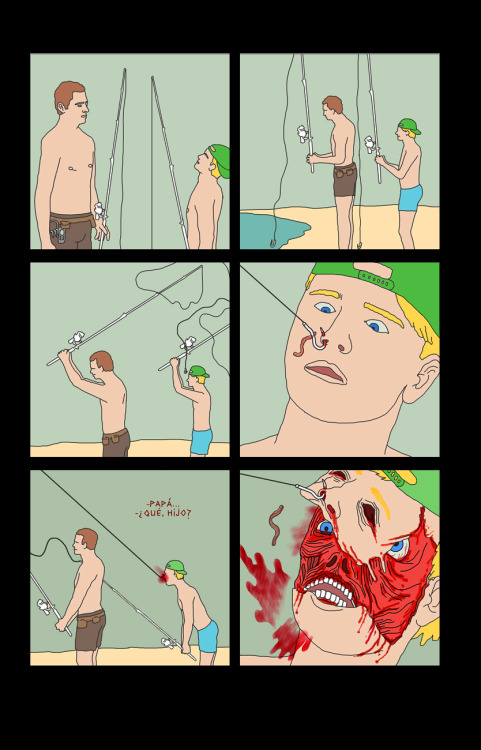


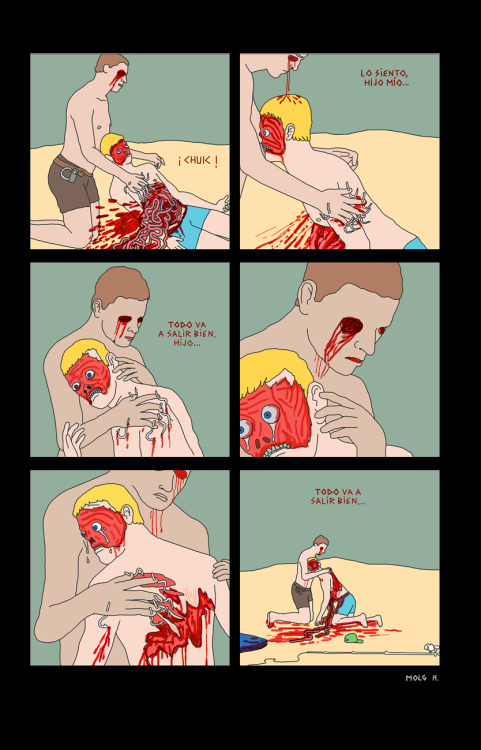
Pieter Hugo shot the series ‘The Hyena & Other Men’ in Nigeria. Pieter was captivated by the first pictures of the ‘hyena men’ that he came across randomly. He went to live with them on the periphery of Abuja in a shantytown – a group of men, a little girl, three hyenas, four monkeys and a few rock pythons.
Nigerian newspapers told him that these men were bank robbers, bodyguards, drug dealers, debt collectors. Myths surrounded them. It turned out that they were a group of itinerant minstrels, performers who used the animals to entertain crowds and sell traditional medicines. Pieter realised that what he found fascinating was the hybridisation of the urban and the wild, and the paradoxical relationship that the handlers have with their animals – sometimes doting and affectionate, sometimes brutal and cruel. When looking back at the notebooks he had kept while with them, the words ‘dominance’, ‘codependence’ and ‘submission’ kept appearing. These pictures depict much more than an exotic group of travelling performers in West Africa. The motifs that linger are the fraught relationships we have with ourselves, with animals and with nature. Read more of Pieter’s fascinating journey here.









All images © Pieter Hugo
A list of the most New York episodes of Seinfeld.
4. "The Rye" (Season 7, Episode 11)
This episode's titular breadstuff-which Jerry steals from an old lady who refuses to sell it to him, even for 50 bucks-supposedly comes from Schnitzer's, a great New York bakery name if we've ever heard one. The real place was called Royale Kosher Bake Shop. Unfortunately, it's now closed. A Jenny Craig branch stands in its place at 237 W. 72nd St. Also in this episode: Kramer leads Beef-a-Reno-fueled hansom cab rides through Central Park. His skills as a tour guide are questionable, though, as his historical "facts" are impressively inaccurate. For example, Frederick Law Olmsted and Calvert Vaux-not former New York Yankee Joe Pepitone-designed the park.
Already good, Seinfeld got 100 times better when I moved to NYC and got 10 more of the jokes per episode.
Tags: lists NYC Seinfeld TV NinjaFridge says, "I found this on reddit and it shows the contestants for Miss Korea 2013." Then he made this GIF. I think they all look pretty different from each other, but it's a fun animation anyway. (Via Kristie Lu Stout)
NinjaFridge says, "I found this on reddit and it shows the contestants for Miss Korea 2013." Then he made this GIF. I think they all look pretty different from each other, but it's a fun animation anyway. (Via Kristie Lu Stout)
    
|
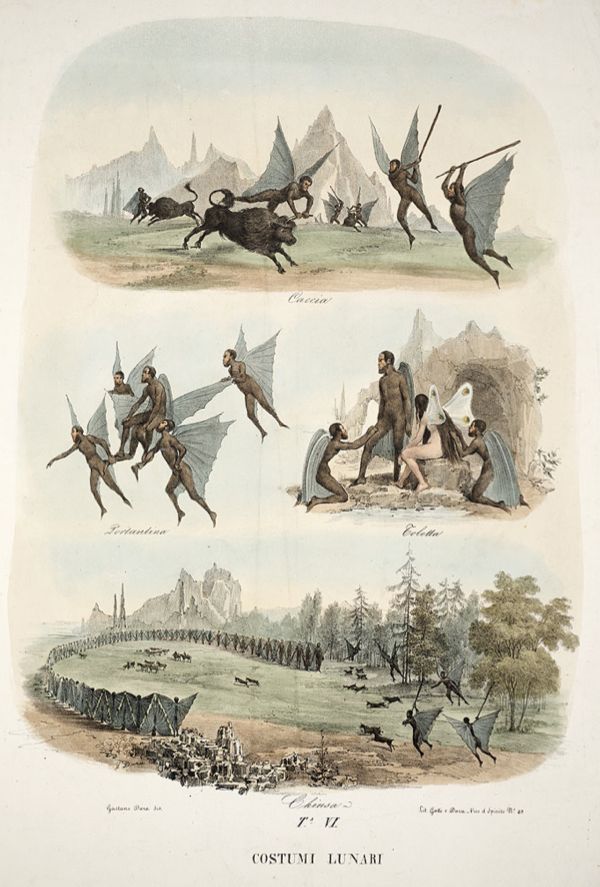 In the old days, Mars was peopled by one vast thinking vegetable, and the Moon was peopled by stick-wielding bat-men and moth-winged moon maidens.
In the old days, Mars was peopled by one vast thinking vegetable, and the Moon was peopled by stick-wielding bat-men and moth-winged moon maidens.
From the Smithsonian Institute Image Collections:
This portfolio of hand-tinted lithographs purports to illustrate the "discovery of life on the moon." In 1836, Richard E. Locke, writing for the New York Sun, claimed that the noted British astronomer Sir John Herschel had discovered life on the moon. Flora and fauna included bat-men, moon maidens (with luna-moth wings), moon bison, and other extravagant life forms. Locke proposed an expedition to the moon using a ship supported by hydrogen balloons.
The first order of business for Earthlings? Enslave the Moon men and slaughter the Moon animals!
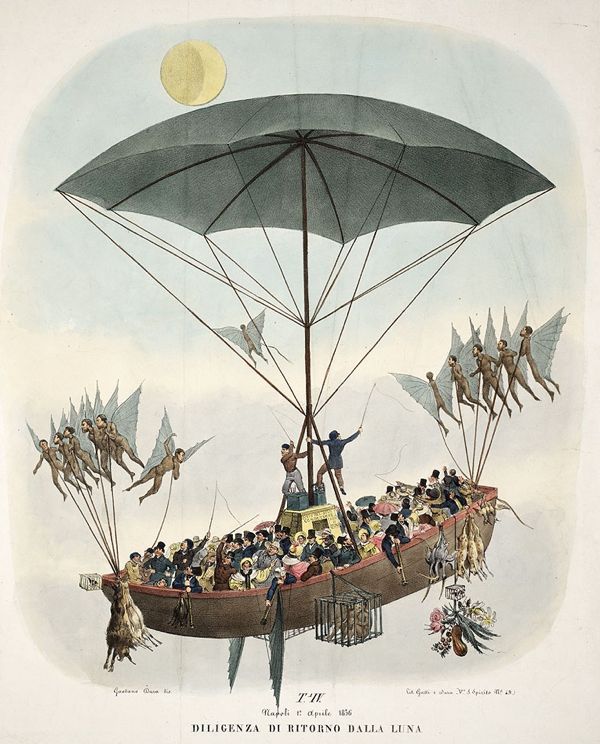
Other discoveries made in the moon from Sigr. Herschel (Via Meine Kleine Fabrik)
    
|

Off the top of your head, how far away from Earth do you think Mars is? If you were to ask me I’d say something ridiculous like, “a million billion miles.” Now there’s a rather fun way of answering that question: a pixel-by-pixel journey from Earth to Mars which takes place in your browser.
Created by David Paliwoda, How Far Is It To Mars? starts with the simple idea that the earth is 100 pixels wide, as you can see above. If the Earth is 100 pixels wide then it would be 3000 pixels to the Moon (which would only be 27 pixels wide, for comparison). You then zoom down the page, travelling toward Mars at a rate of 7,000 pixels per second. It honestly takes a good minute or two to get down to Mars, which ends up being 428,000 pixels away.
You really need to just click the link and do this for yourself. Using pixels and the browser as a way to measure scale is actually a really neat idea, one I haven’t personally seen before. I feel like we might start seeing more of this sort of exploration in the near future.
Before I bought this game I was a bricklayer, and not a very good one at that. I had the dexterity of a two year old in the midst of an epilectic fit. However, having played this game for a month I donned some scrubs and walzed into the workers entrance of my local hospital. Such is the shortage of medical staff here no-one questioned my credentials, and by the end of the evening I'd performed two tonselectomies and a heart bypass. After a week the mortality rate had only risen 5%, and so I continue my game. If an operation is scheduled that I don't know, I just fire up the PC and have a practise: with the realism in this game I'd feel confident wielding a scalpel on my own daughter. I would give her a rhinoplasty, but shes fitted a bolt to her door and won't go to sleep until she hears me snoring now.Delivery Truck Simulator:
My wish-list for the next version - ability to shout at colleagues in the warehouse in an abusive way, taking calls from customers and telling them that the parcel is on the truck and will be with them within the hour, having a long tea-break in the layby on the A408 and being able to throw the boxes onto the back of the truck rather than place them professionally.Roadworks Simulator:
This game will relight your fire for playing games every night, ALL night! Since I was a child I have always wanted to be part of the road team who take excessive lunch breaks, do very little and hold up traffic packed with people who need to get places.Street Cleaning Simulator:
Part of what makes this so spectacular is how unpredictable it is. When rounding a corner, you feel the tension as to what happens next. Will there be gum on the floor? Will a burger have been dropped? Has someone left a newspaper by the curb? I sometimes had to put the game down and go for a walk to calm myself. With such impressive and articulate missions such as "Clean the curb on Anderson street" and "Clean the curb in Market Way", it is obvious as to why you would play this game for hours at a time.Previously: Mundane Simulation.

We've learned a great deal about Star Wars 1313 over the past few months, and today we've got one more huge detail thanks to a reliable Kotaku source: last year, just before E3, LucasArts shifted focus and turned it into a game about the masked bounty hunter Boba Fett.
This happened last May. Star Wars creator George Lucas looked at 1313—which at that point had been scrapped and refocused multiple times—and told the team he wanted it to be about Boba Fett, the mercenary whose origins as a clone were revealed in the Star Wars prequel movies.
You can see concept art from this version of Star Wars 1313 above. Boba Fett stands over someone who looks a whole lot like Bossk, a lizard-like bounty hunter who Fett has apparently captured. They appear to be in the seedy underworld of Coruscant.
Sadly, LucasFilm cancelled the troubled game yesterday, when they shut down LucasArts, the 30-year-old video game studio responsible for 1313, among many other games. Although LucasFilm has said that 1313 and the studio's other cancelled game, Star Wars: First Assault, could be licensed out to other developers, I've been told by multiple sources that chances are very slim. Development on the game had been on hold since last fall, as we reported in February.
"They ended up with movie tech that wouldn't fit in a game, and game tech that wouldn't fit in a movie," a source told me. "1313 was always in danger of not being made."
Bad news for Star Wars fans. For now, here's some more concept art, depicting Boba Fett among a group of other soldiers or mercenaries.

Submitted by: capsula
Posted at: 2013-04-03 05:22:28
See full post and comment: http://9gag.com/gag/6985542
A reader of Free Range Kids is in danger of having his six-year-old daughter taken into protective services custody because he let her walk a few blocks to the post office in their Ohio town. The kid, Emily, asked for a little independence, and was given permission to take some unsupervised, short walks. Neighbors and cops freaked out, detained her, detained her parents, sent CPS after them, and has made their life into a nightmare -- one that's just getting worse and worse.
Day 41: We are served with a complaint alleging neglect and dependency. The County wants to take Emily into “protective supervision” or “temporary custody.” The complaint contains many factual errors and inaccuracies.
There is also a motion for “pre-dispositional interim orders.” As I understand it, this is a mechanism by which CPS can intervene even before the merits of the case against us for neglect are even heard, but less decided. It is scheduled to take place more than a month before the hearing on the neglect charge. It asks the court to force my wife and I to “allow ______ County Children Services to complete an assessment with the family. This is including allowing the agency access in the home, allowing the agency to interview the children, and participate openly in the assessment process.” In other words, they want to search our house, interrogate the children, and force us to testify.
We are trying our best to raise Emily to be responsible, curious, and capable. We have chosen to include teaching her about using the library, navigating the neighborhood, and mailing letters as elements of her homeschooling. Needless to say, this entire ordeal has been quite distressing for the entire family, and we view it as a threat to our homeschooling her, our parental rights, and both my and Emily’s civil liberties. Since our family is being threatened by legal action, I have tried to confine my comments to a dispassionate statement of known facts.
As Lenore Skenazy notes, this shouldn't deter you from letting your own kids move independently about their towns: "I am posting this story NOT because it is common and we should all worry about being hounded by CPS if we let our kids go outside. I am posting it in utter outrage at the idea that a child on her own could be considered neglected or in danger when she is so obviously, clearly, and indisputably neither."
They're looking for pro bono legal assistance.
6-y.o. Who Walked Alone to Post Office May be Removed from Her Home ![]()
 |
 |
McDonald's started out as McDonald's Bar-B-Q in San Bernardino, CA in 1940. Here's a copy of the menu from that time:

The drive-in BBQ restaurant was a great success:
The restaurant had carhops serving guests and would often see 125 cars crowding the lot on weekends. They quickly saw their annual sales topping $200,000 on a regular basis.
But competitors opened similar restaurants and they were selling more hamburgers than barbequed ham so the McDonald brothers closed their place for three months to retool. They reopened as plain old McDonald's, serving cheap fare (like hamburgers) quickly. This is what an early version of the menu looked like:

The original McDonald's served potato chips and pie, which were swapped out for french fries and milkshakes after the first year; that photo must have been taken sometime after the switch. Ray Kroc got involved in 1955 and opened the first McDonald's franchise east of the Mississippi in Des Plaines, Illinois:
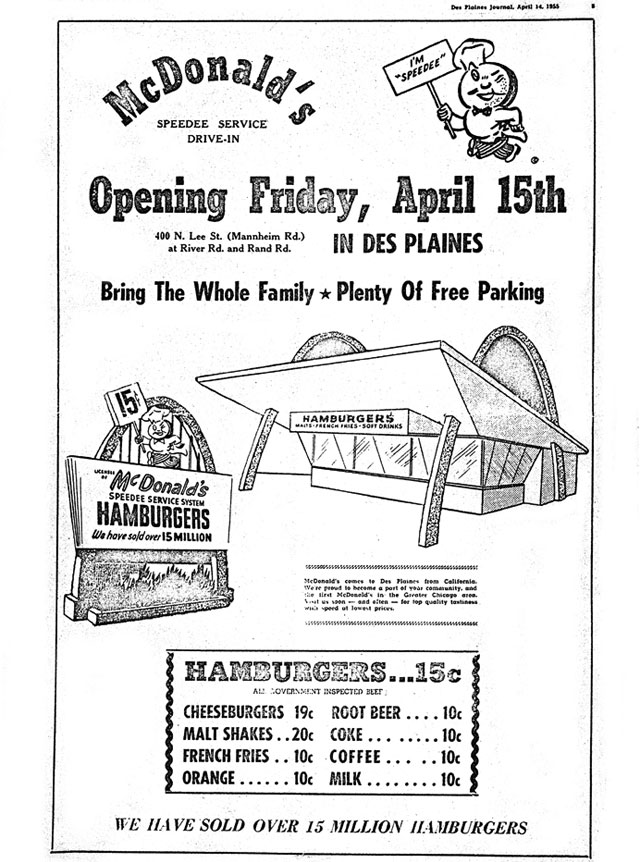
The version of the menu currently going around (on Reddit; I found it here) looks like it's from the Kroc era, the arches having been introduced in 1953, shortly before he got involved:

It's interesting to compare these early McDonald's menus to the current menus of places like In-N-Out Burger and Five Guys, especially in comparison with the sprawling McDonald's menu of today:

After reading all these menus, you're probably getting hungry. So here's how to make a hamburger that tastes like an original McDonald's hamburger from 1948 (as well as recipes for a bunch of other McDonald's menu items, from McNuggets to the McRib to the dipping sauces). Enjoy!
Tags: food McDonald's restaurantsJpdjango es una mierda
I waited to write about Django Unchained because I couldn’t figure out how to account for its maddening effects. But they’ve gotten more and more maddening over time, to the point that I found myself in a restaurant the other night ranting about the sheer horror of hearing Jim Croce’s soporific ‘70s soft-rock ballad “I Got a Name” scored over should-be-exhilarating shots of Django as a newly freed man riding a fine horse through a grand Western snow-scape.
Sorry, other patrons of the restaurant in question! But consider the provocation! “I Got a Name,” for the love of Christ, right there in the middle of my pre-Civil War slave-revenge epic that I’ve been waiting a year to see! “I Got a Name”! I mean, why not the mellow stylings of James Taylor while we’re at it? Maybe Django could sing “You Got a Friend” to his horse or something! My God! Has the whole world gone crazy?
So what the hell, after that there’s no point holding back.
Let me just say that I’m not enjoying hating Django Unchained while so many others have a good time loving it. Hating Django Unchained puts me in company I really don’t want to keep. Fretters who can’t bear the idea of revenge narratives or filmed violence. Morons who hate genre movies. Spike Lee.
I’m not with them, I swear!
The problem here isn’t that Quentin Tarantino made an ultra-violent film about a slave’s epic revenge—that’s what I wanted, that was the whole point. It’s that he turned it into a big lame fatheaded joke with a Jim Croce song in it. That’s unforgivable. Greatest opportunity a filmmaker has had in years, and he fucked it up.
And the bitter irony is, I read the script months ago, so deep-down, underneath all my fondest hopes, I knew he was going to fuck it up.
Here’s what I wrote last February:
…Django Unchained is the Tarantino film that takes on slavery in America, turning it into a kind of Spaghetti Western bloodbath relocated to the Deep South….I’ve got a lot riding on this radical “Southern.” Big emotional investment, partly because of how rotten American films are lately and how much a new genre is needed to breathe a little life into them. And partly because I have so much faith in genre film as The Better Way to approach cultural history and experience, better because genre actually works. It has an impact, influences how people feel. History lessons and documentaries and high-minded period dramas, when they can’t be avoided, sometimes have their place in making us think dutiful thoughts. But an effective genre film…can go right into our nerve centers and makes us love things, and hate other things, and long for a scenario in which to act on our feelings.
That all might be very deplorable or even dangerous—some people think so, anyway—but there it is….
Django Unchained is about how the slave Django (to be played by Jamie Foxx) is unexpectedly freed by an urbane German bounty hunter, Dr. Schultz (Basterd’s celebrated Christoph Waltz) and teams up with him to go on a plantation raid to free Django’s wife Broomhilda (Kerry Washington). The despicable plantation owner Calvin Candie (Leonardo DiCaprio) uses his spread as a giant “house of ill-repuke” as Popeye would say, for white Southern gents with a hankering for “ponies,” generally light-skinned female slaves judged the best-looking. “Candyland” also showcases a slave-fighting ring featuring “mandingo” gladiators who battle to the death.
Obviously, all that has to be stopped in the goriest way possible. Fine, good. Necessary, even. An ultra-violent, vengeful “Southern” can be the pop media form of “the fire next time” James Baldwin promised us: “We are going to burn down your house.” On film, anyway.
Make that a plantation house in antebellum Mississippi and what decent person, black or white, doesn’t want to help torch it?
But the problem is, it all reads so…stupid. Tarantino’s script is everything his detractors say he is, derivative, obnoxious, juvenile. There are terrible scenes of cornball humor, like when Django…wear[s] a blue satin Little Lord Fauntleroy outfit in order to impersonate Dr. Schultz’s valet, and is confronted by a slave:
“Betina: What’cha do for your massa’?
Django: Didn’t you hear him tell ya, I ain’t no slave.
Betina: So you really free?
Django: Yes.
Betina: You mean you wanna dress like that?
Django fumes.”
You come to dread the scene descriptions because they’re so embarrassing:
“The men go to different stores to purchase Django’s wardrobe….Django looks damn handsome in his new duds. Brown cowboy boots, Green Corduroy Jacket, Smokey Grey shirt, Tan Skin Tight Pants, and Light Brown Cowboy Hat. He looks a bit like Elvis in “Flaming Star” and a Little Joe Cartwright on “Bonanza.””
Or this one:
“Stephen has been Calvin’s slave since he was a little boy. And in (almost) every way is the 2nd most powerful person at Candyland. Like the characters Basil Rathbone would play in swashbucklers, evil, scheming, intriguing men, always trying to manipulate power for their own self interest. Well that describes Stephen to a tee.
The Basil Rathbone of House Niggers.”
Tarantino writes like some of my students, and he’s getting way too old for that. All that writing-like-talking can be great if you’ve got control over it (see Mark Twain), but it’s godawful when you suffer from logorrhea and have the sensibility of a stoat. Tarantino’s ain’t-it-cool gloating is just as hot for the joys of Candyland, which he seems to wish he could visit personally—maybe he and Leo having a pony-party—as it is for the burning of Candyland.
But everything equally “awesome” gets boring fast, and finally has no impact. Django’s revenge just tails off into nothing—I can hardly remember it. There’s no slave uprising, no Nat Turner action. Django and Broomhilda are somehow going to escape from the Deep South on their own after wasting everyone at Candyland, and lead really cool lives somewhere. Maybe head to California, open a store on Melrose Ave., sell the Django Look, corduroy jackets and skin-tight pants…?
Hell, Tarantino’s half-convinced me the PBS types are right: you can’t deal with slavery in a genre film, it’s insulting. You think of every old photo of a slave you ever saw, and wonder how Tarantino could write such crap. And here’s the guy who wants to make a movie about John Brown! It’s laughable!
Still, I hope I’m wrong. Maybe it just reads stupid, and all the sound and visuals will transform it. Or maybe he’s on the set desperately rewriting the script between takes. He should be.
Yes, I had naïve hopes that Tarantino could bring it off in spite of everything. But no. No, no, no, no, no—that was me in the theater during most of the movie, with one stream of word-thoughts running constantly in my head—oh, no no no no no no NO.
The fucking thing’s a tonal nightmare, wrong here, wrong there, all adding up to one giant mess of wrong. From the time Dr. Schultz shows up in the first scene driving a little caravan with a gigantic plaster tooth on top of it, attached to a spring so it bounces around goofily to advertise his supposed trade of dentistry, I found myself in a kind of cinema-hell.
Even prepared as I was, I couldn’t believe what I was looking at, this goony series of expensively overproduced skits about slavery, built for guffaws as much as for “ewww” reactions over gloppy blood spurts that accompany all the shooting scenes—the cost of the fake-blood-thickener they were apparently using must’ve almost busted the budget. There’s Jamie Foxx striking Bonanza poses in his fancy new duds. There’s Samuel L. Jackson, wearing an Uncle Ben’s Converted Rice get-up, playing one of those uppity Gone With the Wind-type slaves who get laughs by giving their masters a lotta lip. There’s Tarantino himself swaggering up as an Australian slave-driver with a cartoonishly bad “G’day mate!” attempt at an accent.
Sure, there are some fine things in the film—great actors, lush cinematography—but that can’t salvage the sheer amount of dumbfuckery going on. Prime example: there are horses doing tricks, repeatedly. The last shot, over the grand finale of the exploding Candyland plantations house, is Django showing Broomhilda that he taught his horse how to do some annoying dressage move.
It’s ghastly. All the controversy surrounding the movie seems to miss this central point, that Tarantino’s punctuating what ideally should be a serious-as-a-heart-attack revenge film with inane laffs and hijinks. It’s adding insult to injury that now Big T is going around to interviewers pontificating about the horrors of slavery and how all his research indicates it was far worse than he depicts—duh!—as if he’d just made an avenging-slavery movie that’d give you nightmares for weeks.
But he hasn’t. It’s what he SHOULD’VE done.
And I realize I’m arguing that what’s wrong with Tarantino’s Django Unchained is that he didn’t make a totally different Django Unchained, i.e., the one I wanted to see, about a Nat Turner-esque slave revolt. That seeming unreasonableness kept me from writing about this movie for awhile, too.
But fortunately, somebody else found the reasonable basis for such an argument, and had more nerve than I did. Here’s a quote from Remeike Forbes’ astute article in Jacobin Magazine called “Why Django Can’t Revolt”:
Django Unchained‘s single obsession with the hero’s manhood renders more epic possibilities unimaginable. One question looms over the film — where’s the slave rebellion? Even Calvin Candie asks himself this.
Remarkably, a story about slave-on-slaver violence barely makes a nod at slave revolt. Some might say that such a grand gesture isn’t really in Tarantino’s repertoire, but Inglorious Basterds shows this to not be the case at all. In the movie he allows for history to be completely rewritten, as a band of Jewish-American soldiers and a Jewish theater owner murder the entire Nazi leadership in one night. Why then should something as plausible as a slave revolt be considered an absurdity?
There is one moment that seems like the perfect opportunity for Django to evolve from his lone gun-slinging to rallying others to fight. After fooling his captors and preparing his return to Candyland, Django goes over to the wagon where a few of Candie’s former slaves are sitting in a cage. One would imagine that now free and moved by Django’s feats at least one person, if not all, would join him and take the opportunity to reap revenge on the Candie plantation, where they themselves had lived dehumanizing lives as Mandingo fighters. Instead, they look on at Django awestruck, as he rides off. I guess their balls just weren’t quite as big as Jamie Foxx’s.
Forbes has zeroed in on one of two really telling points in the narrative, when it seems like Tarantino is deliberately psyching us out with the possibility of Django joining forces with other slaves.
The first is the opening scene, when Django, a member of a chain gang of manacled slaves shuffling through the harsh cold terrain of Texas in winter, is liberated by Dr. Schultz, who shoots the slavers. Dr. Schultz then counsels the other slaves about how to negotiate their own way to freedom, and Christoph Waltz’s singsong voice is light and frolicsome throughout. Django never speaks to them, seems too shocked by rapid developments. This seems like the film’s starting point on slavery: there is no cooperation among slaves, there’s hardly even sympathy or communication amongst slaves, and therefore, no possibility of united action. We know that’s not true as a rule, historically. But as a genre film set-up it might work well if, for instance, you intended to rectify that terrible state of affairs with gradually increasing sympathy, communication, and cooperation, all leading up to a goddamn SLAVE REVOLT.
Instead, later on, as Forbes indicates, evil Calvin Candie speculates about the reasons why slaves don’t revolt, and makes a lengthy, outrageous argument, illustrated with the skull of a dead slave, that black people in general are biologically inclined toward submission. Only one in ten-thousand, Candie opines, would prove to be the exception to this rule. At the climactic moment of the movie, Django proudly announces himself as that one non-submitting black person, embracing Candie’s theory.
It’s a hell of a thing, lemme tell ya.
The second time in the movie that the possibility of a slave revolt gets dangled in front of us is the more egregious one. Django gets freed from his captors once more—actually, frees himself this time, through smooth-talking guile followed by unforeseen violence, clearly demonstrating what he’s learned from Dr. Schultz in their bounty-hunting ventures—and once again he’s looking at his fellow black men, who are still sitting in the cage, though the door is open.
The scene is held dramatically, letting us consider what’s about to happen next. Pretty clear Tarantino is building expectations—will they leap up to join him, or will Django have to urge them to grab this extraordinary chance at revenge and freedom…? Nah, neither. Django demands the dynamite and rides off, the other men staring after him. Then, the shootings—Broomhilda rescued—Candyland goes kaboom—dressage—THE END.
It seemed so artificial and atrocious an ending, I thought, there has to be something else going on in the film that justifies this, and I’m just not getting it. Tarantino ain’t THAT crazy. Turned out a friend of mind had a theory about how the whole movie is really a meditation on contemporary “slavery” in the form of the inescapable, exploitative worker system we’re all enmeshed in right now. Or something like that. I was trying to follow it—it got kind of tricky in its particulars—but the restaurant was getting loud and the drinks were going around and pretty soon I lost the thread. Not sure it would’ve mattered anyway, because the last thing I wanted of Django Unchained was some allegorical exercise. The first major Hollywood genre film about slavery with the slaves as the heroes, and we’re going to get meta about it? On purpose?
But I don’t know how else to explain the movie’s unique rottenness. Or the Jim Croce song. Readers, please advise.